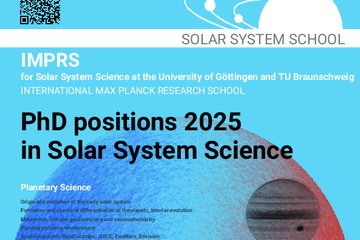All genres
81.
Journal Article
Solar spicules and macrospicules observed by SUMER. Astronomy and Astrophysics 360, pp. 351 - 362 (2000)
82.
Journal Article
Die Quellen des schnellen Sonnenwindes. Physikalische Blätter 56, pp. 51 - 53 (2000)
83.
Journal Article
On the source regions of the fast solar wind in polar coronal holes. Astronomy and Astrophysics 353, pp. 749 - 756 (2000)
84.
Journal Article
Solar irradiances of ultraviolet emission lines measured during the minimum of sunspot activity in 1996 and 1997. Physics and Chemistry of the Earth C, 25, pp. 389 - 392 (2000)
85.
Journal Article
Solar spectroradiometry with the telescope and spectrograph SUMER on the Solar and Heliospheric Observatory SOHO. Metrologia 37, pp. 393 - 398 (2000)
86.
Journal Article
Nonlinear sunspot transition region oscillations in NOAA 8378. Astrophysical Journal 517, pp. L159 - L162 (1999)
87.
Journal Article
Sunspot transition region oscillations in NOAA 8156. Astrophysical Journal 511, pp. L121 - L124 (1999)
88.
Journal Article
Statistical Analysis of EUV Lines Inside and Outside of Solar Coronal Holes. Space Science Reviews 87, pp. 161 - 164 (1999)
89.
Journal Article
The Ne VIII (λ770) resonance line: Solar wavelengths determined by SUMER on SOHO. Astronomy and Astrophysics 346, pp. 285 - 294 (1999)
90.
Journal Article
A comparison between measurements of solar EUV spectral line intensities emitted by C, N, O, and S ions and theoretical calculations. Astrophysical Journal 518, pp. 909 - 917 (1999)
91.
Journal Article
Analysis of extreme-ultraviolet off-limb spectra obtained with SUMER/SOHO: Ne VI/MG VI emission lines. Astrophysical Journal 517, pp. 516 - 525 (1999)
92.
Journal Article
A new Sun: Probing solar plasmas in the EUV light from SUMER on SOHO. Current Science 77, pp. 1521 - 1529 (1999)
93.
Journal Article
Properties of quiet-sun coronal plasmas at distances of 1.03 lt;= RS lt;= 1.50 along the solar equatorial plane. Astrophysical Journal 518, pp. 500 - 507 (1999)
94.
Journal Article
Solar wind outflow and the chromospheric magnetic network. Science 283, pp. 810 - 813 (1999)
95.
Journal Article
Search for Signatures of a Coronal Hole in Transition Region Lines Near Disk Center. Space Science Reviews 87, pp. 249 - 252 (1999)
96.
Journal Article
Proton and hydrogen temperatures at the base of the solar polar corona. Astronomy and Astrophysics 347, pp. 676 - 683 (1999)
97.
Journal Article
Evidence for non-Maxwellian electron energy distributions in the solar transition region: Si III line ratios from SUMER. Astrophysical Journal 527, pp. 1000 - 1008 (1999)
98.
Journal Article
Signatures of coronal hole spectra between 660 and 1460 Å measured with SUMER on SOHO. Space Science Reviews 87, pp. 299 - 302 (1999)
99.
Journal Article
SOHO: Der ungetrübte Blick auf die Sonne. Sterne und Weltraum Special 4, pp. 38 - 41 (1999)
100.
Journal Article
Die wichtigsten Sonnenmissionen. Beobachtung der Sonne mit Satellitenteleskopen. Sterne unda Weltraum Special 4, p. 110 (1999)











